Are you ready to elevate your style literally without sacrificing comfort? Wearing heels can be a game changer for your confidence and fashion game, but let’s face it. Those first steps can feel like walking on stilts. Many women struggle to balance fashion and comfort, but with the right strategy and practice, you can conquer the world of high heels with grace. Whether you’re a heel novice or looking to up your stiletto game, this guide will walk you through the step by step process to help you feel confident and comfortable in your heels.
Learn more about the 48 Dress Types and What They Mean in our guide
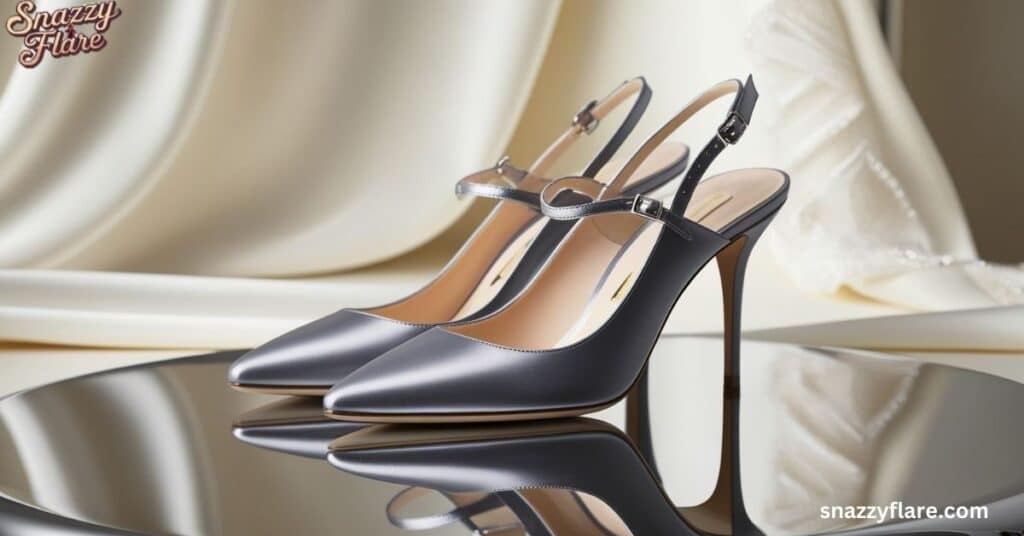
Step by Step Guide: Mastering Heels with Confidence
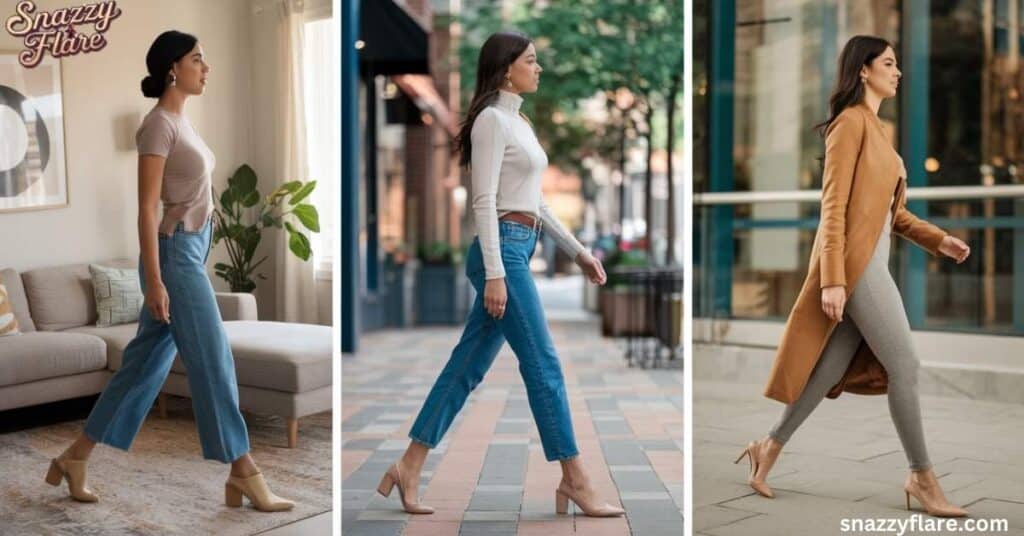
Whether you’re new to heels or looking to elevate your heel game, following a step by step process ensures you build comfort, confidence, and style. This gradual guide will help you transition smoothly, while also giving you room to adjust according to your comfort level.
Week 1: Start with Low Block Heels (1-2 inches)
- Wear them around the house for 30 minutes daily to get your feet used to the change in posture.
- Focus on finding the right fit to prevent strain or discomfort.
- Practice your walk, paying attention to posture and stride.
In Week 2: Transition to Mid Height Block Heels (2-3 inches)
- Take short outdoor trips, focusing on balance and maintaining good posture.
- Wear heels for longer periods as you build confidence.
- Incorporate ankle strengthening exercises, like yoga or simple balance exercises.
Week 3-4: Move to Thinner Heels (Kitten Heels or Stilettos under 3 inches)
- Start practicing on different surfaces, such as carpets or pavement, to improve stability.
- Continue to increase your walking time and gradually work up to higher, thinner heels for special occasions.
- Strengthen your arches and balance with targeted foot exercises.
Month 2: Wear Higher Heels (3-4 inches) with Confidence
- By now, you should be ready for stilettos or other higher heels for longer periods. Focus on refining your stride and building endurance.
- Continue practicing good posture and use heel inserts for extra comfort if needed.
- Always choose the right shoes and make sure they fit properly to avoid unnecessary discomfort.
Why High Heels Boost Confidence
Let’s kick things off with a question. Why do we put ourselves through the potential discomfort of heels? It’s simple heels have a magical effect on our posture, confidence, and overall appearance. They elongate the legs, accentuate the calf muscles, and add a touch of elegance to any outfit. But as anyone who’s ever wobbled in a pair knows, there’s definitely a learning curve.
“Give a girl the right shoes, and she can conquer the world.” Marilyn Monroe
This quote isn’t just about looking good it’s about feeling powerful. High heels can transform not just your height, but your entire demeanor. However, the key to this transformation is mastering the art of walking in them comfortably.
Understanding Heel Types: Your Foundation for Success
Before we dive into how to get used to heels, let’s break down the different types you might encounter:
Stilettos Heels
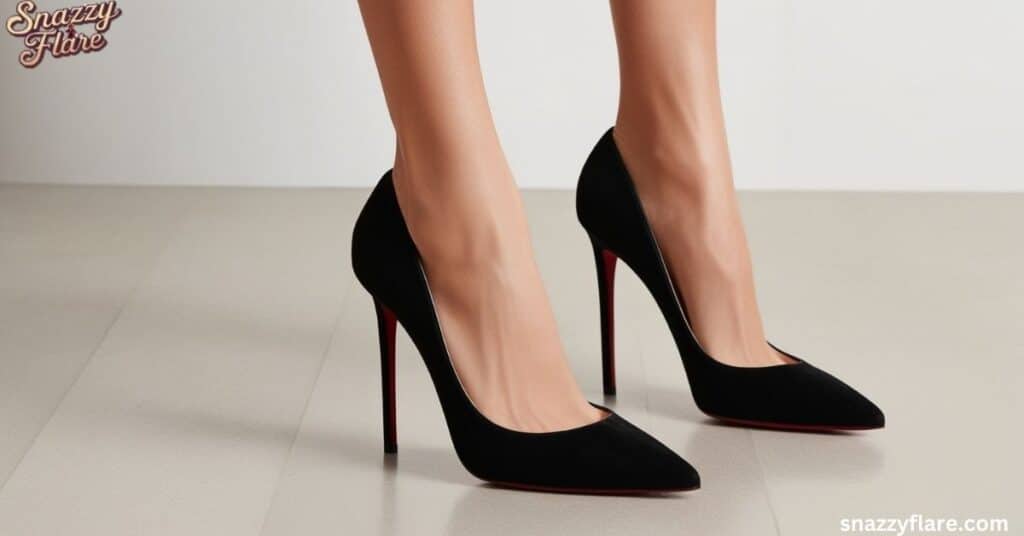
Known for their sleek, narrow design, stiletto heels are typically 3 to 4 inches or higher, creating an elegant silhouette. However, they offer less stability and can strain the foot and ankle, making them challenging for beginners. Perfect for formal events or bold statements, practice is key to wearing them comfortably.
Block Heels
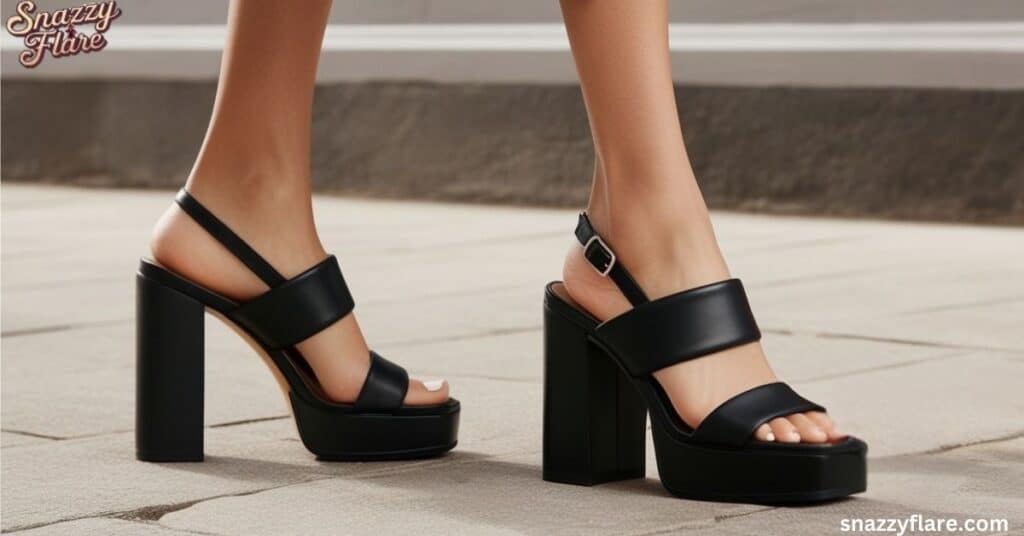
With their wider, chunky design, block heels offer greater stability and comfort. They distribute weight evenly, making them ideal for everyday wear or long standing events. Available in various heights, they provide all day support and are perfect for walking on uneven surfaces.
Kitten Heels
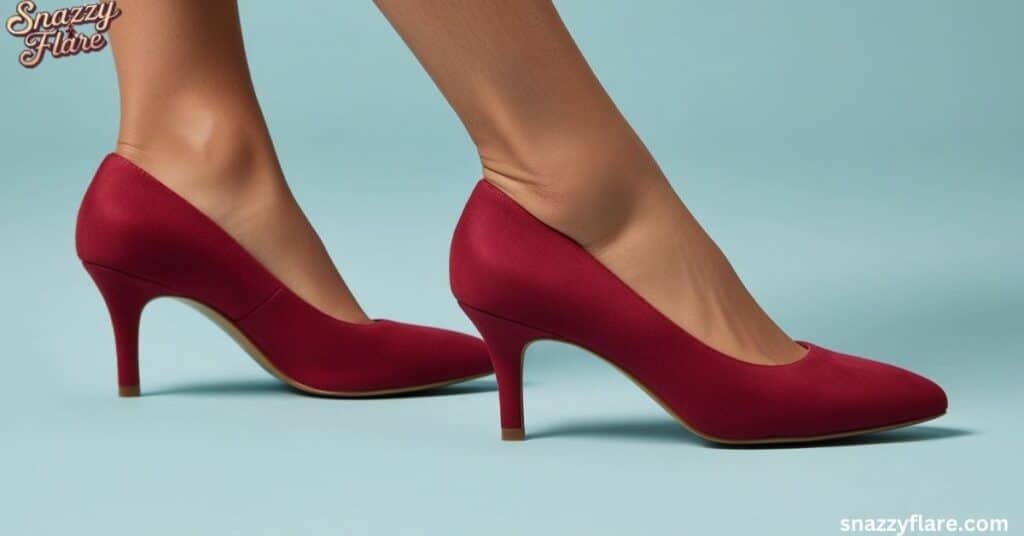
Kitten heels are 1 to 2 inches high, offering a subtle lift without the steep angle of higher heels. They’re comfortable, reduce foot strain, and are great for beginners, work settings, or casual outings, providing a balanced mix of style and comfort.
Wedges Heels
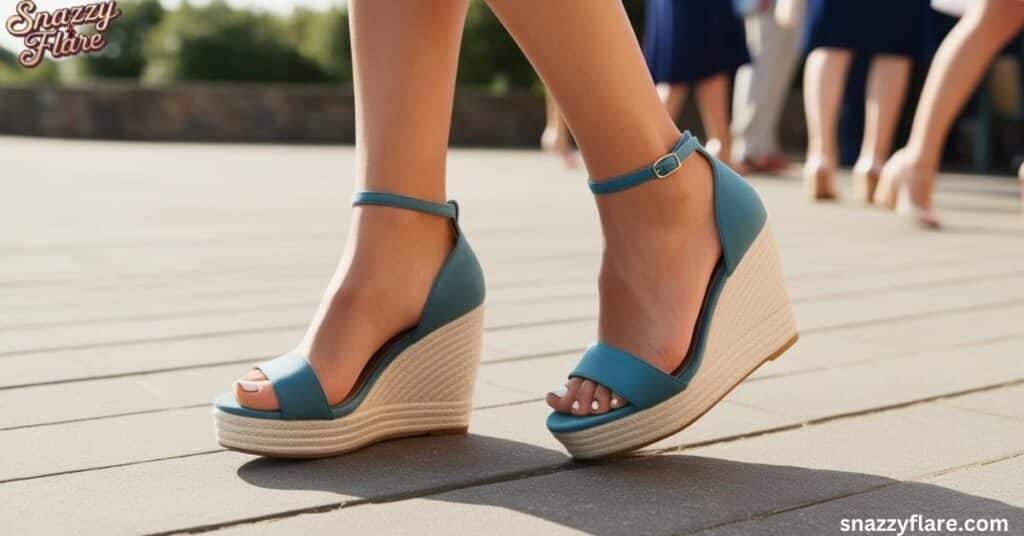
Wedge heels offer full foot support, with a continuous sole that ensures stability and comfort. They distribute weight evenly, making them ideal for outdoor events where thin heels might sink into the ground. Wedges are versatile, practical, and stylish for casual or summer occasions.
Platform Heels
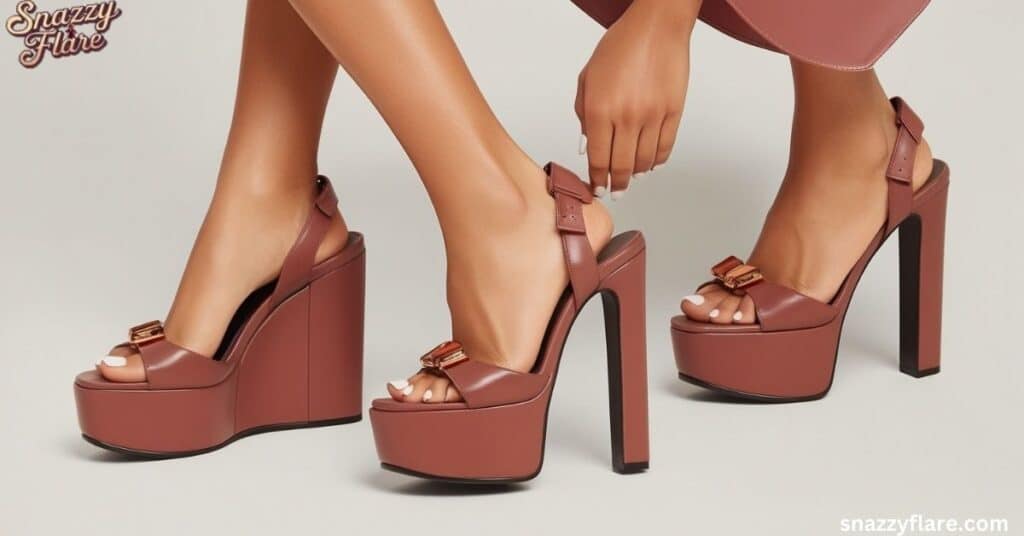
Platform heels add height at the front, reducing foot strain by balancing posture. They offer more comfort than stilettos of the same height, making them a great option for a bold fashion statement without sacrificing too much comfort.
Each type has its pros and cons. For instance, while stilettos offer the most dramatic look, block heels provide better stability for those still finding their footing. Here’s a quick comparison:
| Heel Type | Stability | Style Factor | Comfort Level | Best For |
| Stilettos | Low | High | Low | Special occasions |
| Block Heels | High | Medium | High | Everyday wear |
| Kitten Heels | Medium | Low | High | Beginners |
| Wedges | High | Medium | High | Outdoor events |
| Platforms | Medium | High | Medium | Long-wear days |
Learn about What to wear if you can’t wear heels
The Journey to Heel Comfort: What to Expect
Getting comfortable with heels isn’t an overnight process. It’s more like training for a marathon you’ve got to build up your endurance. Here’s a general timeline.
Week 1-2: Expect some discomfort as your feet adjust to heels. Start with lower heels like kitten or block styles and wear them for short periods (1-2 hours). Gradually, your muscles will strengthen for better balance. Using gel inserts can help ease initial strain on your arches.
Week 3-4: Balance improves, and pain decreases by week three. Try slightly higher heels or wear your current ones longer. Focus on smooth heel-to-toe walking. Practice consistently, but avoid pushing through pain to maintain foot health.
Month 2-3: By now, heels feel natural, and you can incorporate them into your daily wardrobe. Experiment with different styles like stilettos or platforms, but always prioritize comfort. Keep rotating between heels and flats to protect foot health.
Remember, factors like age, foot shape, and lifestyle can affect how quickly you adapt. Don’t rush the process, your feet will thank you.
How to Walk Gracefully in Heels
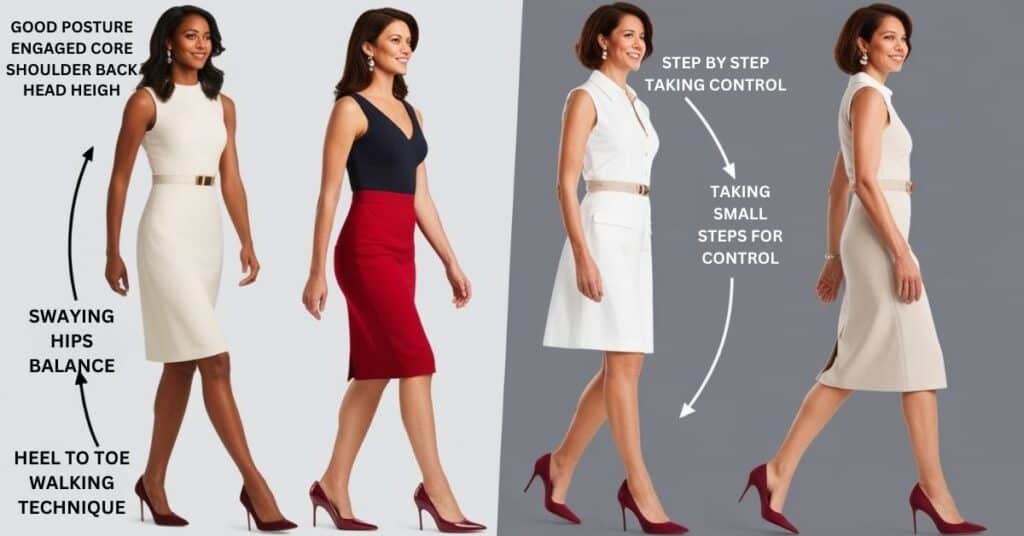
Now, let’s talk about how to actually walk correctly in those heels. It’s not just about putting one foot in front of the other!
- Posture is key
Engage your core, keep your shoulders back, and lift your head high to maintain balance and reduce strain. Good posture improves your appearance and helps prevent discomfort. - Heel to toe
Always step with your heel first, then roll to your toe for a smooth motion. This technique improves balance and reduces the risk of tripping. - Smaller steps
Take shorter strides to maintain control and balance. Slow, deliberate steps reduce foot strain and allow for a more graceful walk. - Use your hips
Let your hips sway naturally to maintain balance. This adds fluidity to your walk and helps with stability. - Practice
Walk on various surfaces at home to get used to heels. Practicing ensures confidence and reduces the chance of stumbling.
Practice these techniques at home before hitting the streets. Try walking on different surfaces, including carpet, hardwood, and even grass (carefully).
Heel Comfort Tips: Avoid Pain and Walk with Ease
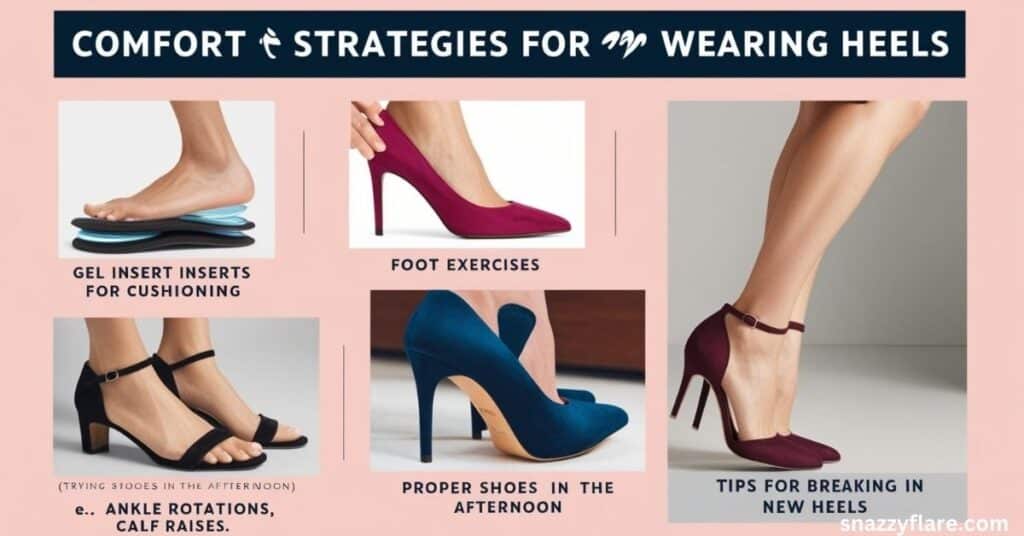
Let’s face it even seasoned heel-wearers can experience discomfort. Here are some pro tips
Size matters
Choose the right size by shopping for heels in the afternoon when your feet are larger. A proper fit prevents discomfort and long term foot issues.
Insoles are your friends
Use gel inserts for extra cushioning, especially at the ball of your foot. They help absorb shock, making heels more comfortable for extended wear.
Break them in
Wear new heels at home with thick socks to soften them and reduce the risk of blisters. This ensures a better fit before wearing them outside.
Strengthen your ankles
Do ankle exercises like rotations or calf raises to improve balance and prevent sprains when wearing heels.
Listen to your body
If a pair of heels consistently hurts, stop wearing them. Always prioritize foot health over discomfort.
Remember, pain isn’t a badge of honor, it’s a sign that something’s not right. If a pair of heels consistently causes pain, it might be time to retire them.
Learn more about pairing heels with dresses in our Types of Dresses Every Woman Should Know
How to Build a Comfortable Heel Collection
- Rome wasn’t built in a day, and neither is a heel collection. Developing a stylish heel wardrobe takes time, so start gradually to build comfort and confidence.
- Begin with Kitten Heels or Small Wedges (1-2 inches) Start with kitten heels or small wedges (1-2 inches) for a subtle lift. These styles offer stability and are perfect for daily wear, helping you ease into heels without discomfort. Brands like Clarks and Naturalizer are known for their comfort-focused designs.
- Graduate to Block Heels or Lower Stilettos (2-3 inches) Next, move to block heel or lower stilettos (2-3 inches). These provide more height while maintaining balance, ideal for various outfits. Lower heel reduce foot strain, making them a practical choice for longer wear.
- Finally, Tackle Those Sky High Stilettos (3+ inches) Finally, embrace sky high stilettos (3 inches and above). While they elevate your look, prioritize foot health with gel pads or arch support.
As Carrie Bradshaw said, “I like my money right where I can see it—hanging in my closet,” underscoring the allure of stylish heels.
This gradual approach allows your feet and legs to adapt over time. It’s not just about heel height it’s about building strength and confidence.
Solutions to Common High Heel Problems
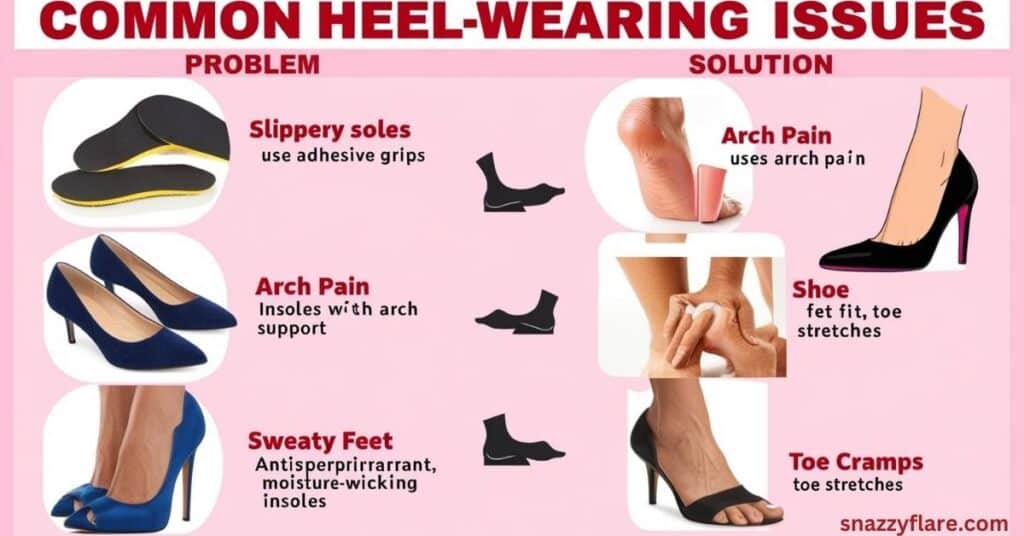
Even heel veterans encounter problems. Here’s how to tackle some common issues effectively.
Slippery Soles
Slippery soles can make walking in heel precarious. To increase traction, scuff the bottom of new heels gently with sandpaper or a pumice stone. Alternatively, consider using adhesive grips that stick to the sole, providing extra friction and stability. This simple adjustment can significantly enhance your confidence and safety while wearing heel.
Arch Pain
Arch pain is a common complaint among heel wearers. To combat this discomfort, seek out heel with built-in arch support or invest in quality supportive insoles. Brands like Dr. Scholl’s offer specialized options designed to alleviate pressure on the arches, allowing for longer wear without pain. Prioritizing comfort in this area can transform your heel experience.
Sweaty Feet
Sweaty feet can lead to discomfort and slipping. To manage this issue, apply antiperspirant directly to your feet before wearing heels. Alternatively, consider moisture-wicking insoles, which help absorb sweat and keep your feet dry. Maintaining dryness not only enhances comfort but also prevents potential foot odor.
Toe Cramps
Toe cramps often result from ill fitting shoes. Ensure your heels aren’t too tight, as this can restrict blood flow. Regularly check the fit and opt for a half size up if necessary. Incorporating toe stretching exercises can also help alleviate tension and improve flexibility, making your heel wearing experience much more enjoyable.
The Psychology of Heel Wearing: More Than Just Fashion
Wearing heel isn’t just about looking taller, it’s about feeling more confident and powerful. Studies have shown that people perceive women in heels as more attractive and competent. But remember, the most important thing is how you feel about them.
“Cinderella is proof that a new pair of shoes can change your life.” Unknown
This quote might be tongue in cheek, but there’s truth to it. The right pair of heels can boost your confidence and change your whole outlook.
Heel Care and Maintenance: Protecting Your Investment
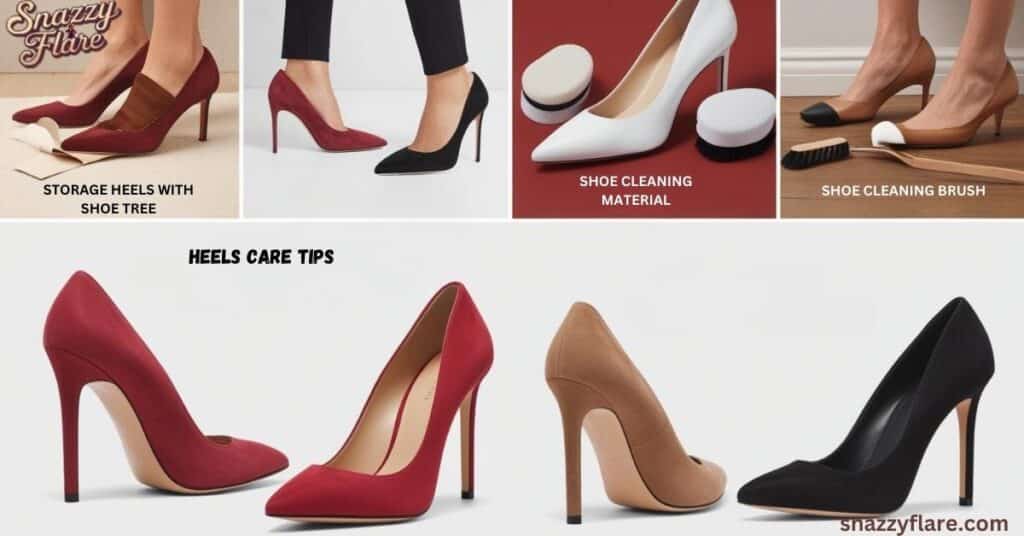
Quality heels aren’t cheap, so take care of them to ensure longevity and maintain their appearance.
Store Them Properly
To keep your heel in top condition, always store them properly. Using shoe trees helps maintain their shape and prevent creasing. Alternatively, stuffing them with clean paper or cloth can also do the trick. Proper storage not only preserves the aesthetics but also prolongs the life of your heel.
Clean Regularly
Regular cleaning is essential for heel maintenance. After each wear, wipe down your heel to remove dirt and moisture. Depending on the material, consider polishing or conditioning them to maintain their luster. A simple weekly clean can prevent buildup and ensure your heels always look their best.
Protect the Heel
To prevent wear and tear, protect your heel tips by adding heel caps. These affordable accessories can absorb impact and extend the life of your heel. They are particularly useful for stilettos, which are more prone to damage. Investing in heel caps can save you from costly repairs or replacements.
Know When to Let Go
It’s vital to recognize when it’s time to replace your heels. If the heel is wobbling or the sole is worn through, continuing to wear them can lead to injury. Regularly assess their condition, and don’t hesitate to let go of heels that have seen better days. Remember, a new pair can often be a safer and more comfortable choice.
Explore our guide to Tea Dresses and master the art of effortless elegance
Advanced Heel Wearing Techniques: Beyond Walking
Once you’ve mastered basic walking, why not level up? Exploring advanced techniques can enhance your comfort and confidence in heels.
Dancing in Heels
Dancing in heels can be a fun challenge. Start with slower dances like the waltz or salsa to get used to the rhythm and balance required. As you gain confidence, gradually transition to faster dances, ensuring your weight remains centered over the balls of your feet. Practicing on a smooth surface can help improve your stability and control.
Running in Heels
While running in heel is not recommended, emergencies may arise. In such cases, keep your weight shifted to the balls of your feet to maintain balance and minimize strain on your ankles. A quick, controlled motion is key; try to avoid long strides, and always assess your surroundings to prevent falls.
All Day Events
For all day events, comfort is crucial. Consider bringing fold up flats for breaks to give your feet a rest. Additionally, apply moleskin to potential blister spots before putting on your heel. This preventative measure can make a significant difference in comfort, allowing you to enjoy the event without the distraction of foot pain.
The Health Perspective: Balancing Style and Well being
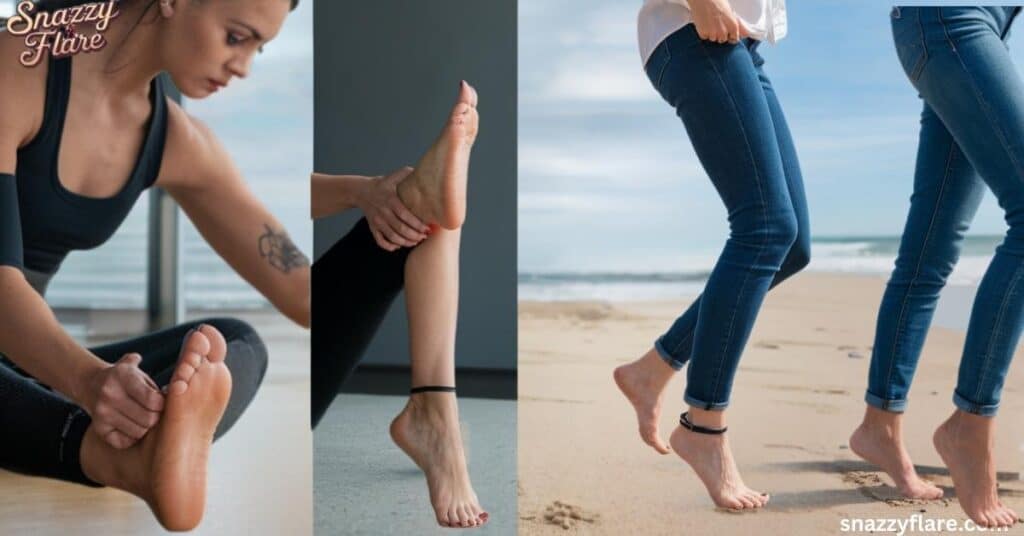
While heels are a fashion staple, it’s essential to consider their impact on your health. Prolonged heel wear can cause long term issues like shortened calf muscles and lower back pain due to the unnatural positioning of the body.
To minimize harm, alternating between heel heights throughout the week helps balance muscle strain. By giving your body time to adjust, you can reduce the risk of injury and maintain comfort without sacrificing style.
Simple foot exercises, such as toe spreads and calf stretches, can alleviate some of the stress heels place on the feet. These exercises strengthen muscles and enhance flexibility, reducing pain over time.
Moderation is key mixing up footwear options, from flats to sneakers, helps keep your feet in good shape. Regular variation can prevent injuries while still letting you enjoy the beauty of heel.
By balancing your love for heel with mindful habits, you can maintain your style and support long-term foot health.
Find the perfect length for your heel outfits in A Guide to Dress Lengths.
Conclusion: Striding Forward with Confidence
Mastering high heels takes practice and care. Start with lower heels, focus on comfort, and practice walking gracefully. Pair proper fit with shoe care to enjoy both style and confidence. With the right techniques, you can wear heels comfortably and conquer any occasion with poise
FAQs
How can I avoid blisters in high heels?
Prevent blisters by wearing thick socks to break in new heel, applying moleskin or blister pads, and using anti-friction balms. Choose well-fitted heels for added comfort.
Can wearing heel regularly cause long-term foot problems?
Yes, wearing heel regularly can lead to issues like foot pain, bunions, and even long-term problems such as shortened calf muscles or joint pain in the knees and back. To minimize these risks, alternate heel heights, wear supportive insoles, and avoid wearing heels for extended periods without breaks.
How do I stretch out new heels that feel too tight?
You can stretch out tight heel by wearing them with thick socks and using a hairdryer to warm up the areas that feel tight. Alternatively, shoe stretchers or taking them to a professional cobbler can help loosen the fit.
What type of heel is best for wide feet?
Block heels or wedges are typically the best options for wide feet, as they provide more stability and distribute weight evenly. Look for styles with wider toe boxes or shoes available in wide sizes to ensure a comfortable fit.
Are there any specific materials or fabrics that are more comfortable for heels?
Leather and suede tend to be more comfortable as they stretch and conform to your feet over time. Look for heel with cushioned insoles and flexible materials that allow for some give, reducing the likelihood of discomfort or blisters.

“Jessica Jone is an experienced fashion blogger at Snazzy Flayer. With a passion for style and a keen eye for trends, she shares practical tips and fashion insights to help readers elevate their everyday looks.”






